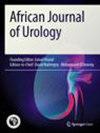A prospective study of the association between varicoceles and semen quality in men with infertility
IF 0.4
Q4 UROLOGY & NEPHROLOGY
引用次数: 0
Abstract
Male infertility is a global problem, and varicoceles are a common and treatable cause of male infertility. This study prospectively evaluated the effects of varicoceles on the fertility status and potential among Nigerian men. The consequences of the presence, location, and grades of varicoceles on the fertility status of infertile men with varicoceles were determined using a Doppler scrotal ultrasound scan and their seminal fluid parameters. One hundred infertile males with clinical varicoceles (study group) and 100 infertile males without varicocele (control group) were recruited. Varicoceles were confirmed/excluded and graded with an ultrasound scan in each subject. They also all had a seminal fluid analysis to measure their fertility potential. The findings were compared and correlated in the two groups. Most subjects in the study group (67%) had bilateral varicoceles, 31% had isolated left varicoceles, and only 2% had isolated right varicoceles. The majority of the participants (61%) in the study group had secondary infertility, while the majority (63%) in the control group had primary infertility (p = 0.001). There were significant increases in the prevalence of azoospermia (p = 0.008) and oligospermia (p = 0.030) with the higher grades of left varicoceles. Bilateral varicoceles were significantly present in males with infertility in the study group. Varicoceles were more common in males with secondary infertility, and higher grades of varicoceles were significantly more associated with azoospermia and severe oligospermia. We recommend the routine use of ultrasound scans to diagnose varicoceles for the optimal management of infertile male patients.不育症男性精索静脉曲张与精液质量关系的前瞻性研究
男性不育是一个全球性问题,而精索静脉曲张是导致男性不育的一个常见且可治疗的原因。这项研究前瞻性地评估了精索静脉曲张对尼日利亚男性生育状况和潜力的影响。研究使用多普勒阴囊超声扫描和精液参数确定了精索静脉曲张的存在、位置和等级对患有精索静脉曲张的不育男性生育状况的影响。招募了 100 名患有临床精索静脉曲张的不育男性(研究组)和 100 名无精索静脉曲张的不育男性(对照组)。每个受试者都通过超声波扫描确认/排除了精索静脉曲张并进行了分级。他们还都进行了精液分析,以测量其生育能力。对两组受试者的结果进行了比较和关联分析。研究组的大多数受试者(67%)患有双侧精索静脉曲张,31%患有孤立的左侧精索静脉曲张,只有2%患有孤立的右侧精索静脉曲张。研究组的大多数受试者(61%)患有继发性不孕症,而对照组的大多数受试者(63%)患有原发性不孕症(P = 0.001)。左侧精索静脉曲张的等级越高,无精子症(p = 0.008)和少精子症(p = 0.030)的发病率就越高。双侧精索静脉曲张在研究组男性不育症患者中明显存在。精索静脉曲张在男性继发性不育症患者中更为常见,而等级越高的精索静脉曲张与无精子症和严重少精子症的相关性越高。我们建议常规使用超声波扫描诊断精索静脉曲张,以便对不育男性患者进行最佳治疗。
本文章由计算机程序翻译,如有差异,请以英文原文为准。
求助全文
约1分钟内获得全文
求助全文

 求助内容:
求助内容: 应助结果提醒方式:
应助结果提醒方式:


